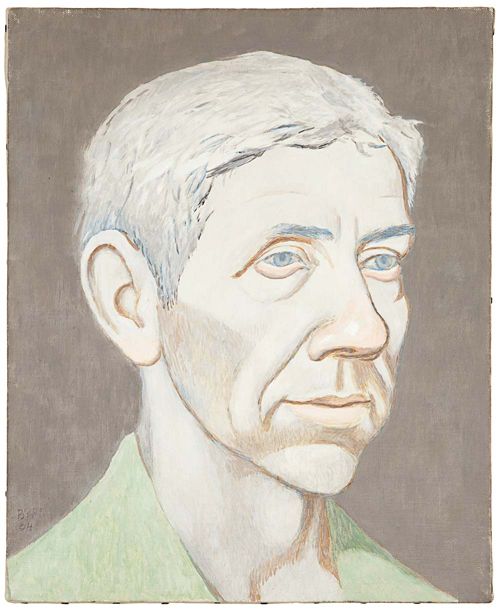
THE ART OF DAVID BYRD
by REBECCA BROWN
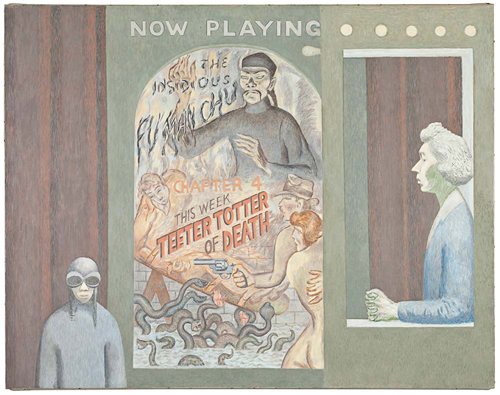
Chapter Four (1994)
a boy in a maska woman behind a 3-sided cage of glass;
the 4th side is the wall behind her back
a guy with a gun
a girl and snakes
a man and flames and
someone with a gun
Except it isn’t actually a mask; it only covers his eyes. He’s in a too-big pilot’s cap and goggles like they used to wear. My father used to wear that kind of cap. We have a picture from near the end of the war when he was in it. The goggles look out and he looks out at you or the world or something past or nothing. Or maybe not even looks but stares, unseeing, at the reflection of his eyes inside the lenses.
The woman in the cage is staring too. The eye of her I only see in profile, but I can see it’s vacant. If she’s looking at something, it isn’t something you or I can see; she’s somewhere else.
Where is she? Where'd she go?

Foster Family (1990)
His mother left the kids when they were young.
Their father’d left them first. Their mother couldn’t make enough alone to support five kids so she abandoned them. During their four years away from Mother, the children lived in three successive foster homes.
A fat lady with a bag you deliver newspapers from. That’s no job for an adult but a boy. She’s fat as the Pillsbury doughboy but not cute. She’s heavy, plodding, trodden down. The ghost of some dead soldier boy is hovering by her feet, the place the young god Mercury would have wings. There’s a small open coffin, a baby dead. Another on the way beneath the dress of another who pushes a stroller. Who wants these kids? Not these. A stoop shouldered monkey of a man, a gaping, tired mouth. What’s in his hands? What is the job he doesn’t want to do? A job is in his hands.
The place you can see the woman is a ticket booth. The tickets are to get away and lose yourself in pictures.

Movie House (1959)
My mother loved the movies when she was young. The movies then were not so “awful,” she told me once, not all about, like ours, “the problems of society.” Who wanted to see, on the movie screen, what they were trying to escape (Depression, Dust Bowl, Breadlines. War.)? The big screen was an antidote: Fred and Ginger sang and danced; Dorothy found her way back home; the west was tamed by good and upright men. Even in the gangster ones, bad guys never won.
But, after the war was over and however it had buoyed whoever it did began to slip into the past, the kids of the people who fought in it began to fight with them. Things weren’t the way in life they showed in movies.
David Byrd was born in l926 in Springfield, Illinois, where Abraham Lincoln had practiced law before he left for Washington. My mom was born in ’28 in Oklahoma City, not too long after statehood, i.e. the annexing (read: obliterating) of the Indian Territory. My mother’s mother had trained to be a doctor, one of the first females to do so back before the place got “civilized.” After she had a child, though, she quit. You couldn’t do both.
After her husband abandoned her, Mother abandoned the children. Then, in l942, when he was sixteen, his mother came back to the children again. It was a happy ending for a while.
The movie poster on the wall between the boy and woman reads:
Now Playing
The Insidious Fuman Chu.
Chapter 4: This Week
Teeter Totter of Death.
After the war, my mother was afraid of “Japanese.” Fuman Chu wasn’t Japanese, but “Oriental” enough. The character of Fu Manchu (from a series of early 20th century novels by Sax Rohmer), is often (dis)credited with creating the pop culture stereotype of the generic Asian “Yellow Peril,” an evil, cold, inscrutable and astonishingly mustachioed criminal “Oriental.” A lot of movies about him were made in the 30s, when David Byrd and my mom were kids, and in the 40s when his mother, and him as an usher, worked at the movies. She sold the tickets; he took you to your seat.
(Insidious: proceeding in a gradual, subtle way, but with harmful effects. As in “Diseases can be insidious and sometimes without symptoms.”
Two synonyms for symptom: mark and sign.)

Shaving (1986)
In 1945 he joined the Merchant Marines.
He travelled and looked at art and sketched.
After the war, on the GI bill, he studied art in Philadelphia and New York. In l958 he got a job as an orderly in the psychiatric ward of the VA hospital. The work at the VA was hard. Sometimes he got to New York to look at art. He looked at art in magazines and tried to sell or place his work, but no one wanted it or wanted him.
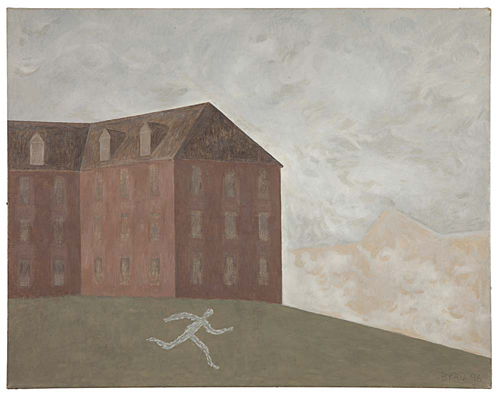
Patient’s Dream (1996)
Something else was hard as well, but what? The time? The going back and forth, the going again and again? That no one in the world of art would give him a home? He kept the job at the VA; he made a lot of art. He did this 30 years.
He lived for years in a shack while he built, a lot by his own hand, a home.

Patients Watching TV (1992)
Over the long and longer years he started to love the human beings with whom he worked.
The people who surrounded him had wounds. They’d been in war (the World War, Korea, Vietnam) and been rendered twitchy, mad or mute or paralytic .They were deficient, broken, wrong, rejected as an orphan from the “normal” social/familial units of the world.
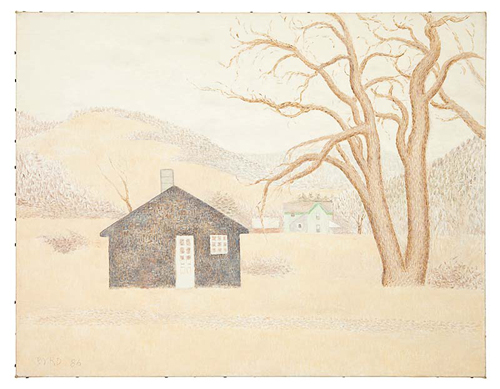
Catskill Shack (1986)
When he retired in 1988 he bought some land in Sidney Center, New York. He lived for years in a shack while he built, a lot by his own hand, a home. He painted and built things and kept them in his home. He built a yard around his home and filled it with objects that drew the attention of a neighbor, Jody Isaacson. When Isaacson, an artist and transplant from Seattle, worked up the nerve to ask him about his yard, Byrd invited her in. Inside his home she found more than 400 paintings, drawings and objects. The place was packed, but tidy. Byrd had hung larger canvases over smaller ones, sometimes three deep, to accommodate the work.
Landscapes he passed on the way to work, a gas station at night, a bridge, a barn, a laundromat. Though aware of developments in the visual arts, Byrd continued to work in a social realist modes of the 30s and 40s. The palette was muted, dusty, like things are covered with a fine, dry powder or misremembered slightly over time (Morandi, faded de Chirico, George Tooker without the shine). Genre scenes: collectors at a bottle show or auction; boxing match, a seamstress and a butcher shop. An awful lot of of people in the psych ward.
Though in his decades of making art he’d never had a gallery show, Isaacson made that happen. She contacted a number of New York galleries but no firm offers have come yet. Then Isaacson introduced Greg Kucera, whose Seattle-based gallery represents her, to Byrd’s work. Kucera flew to Sidney Center and recognized immediately the presence of something wonderful. Kucera rescheduled the two exhibits previously slotted for April/May 2013, and gave the entire gallery over to 105 works of art by Byrd. The work was loved tremendously; 3/4 of it sold. A few days before flying to Seattle for the first gallery show of his life, Byrd was diagnosed with cancer. He died shortly after the exhibit closed, aware, at last, his art was loved.
+ + +
Some Pictures at an Exhibition
At the VA he was surrounded by people whose wounds had made them orphaned from the world.
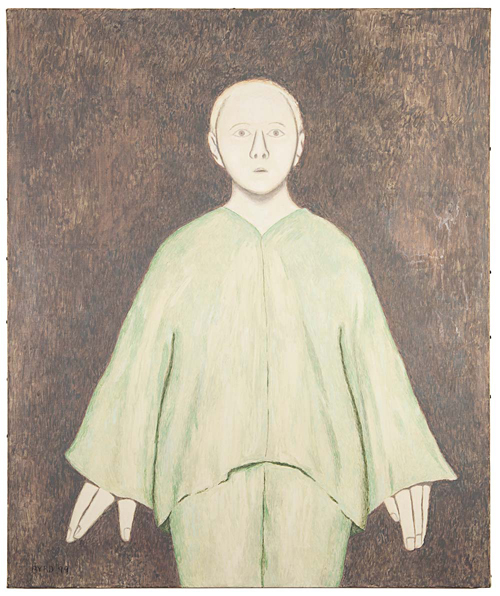
Lobotomy (1999)
The only one who’s centered and is looking out at you. The only one symmetric, middle-split. The hands at one’s side pose as if for flight or to push back something that follows one. One’s hands discreet so that no one else can see. There’s something in the red and black surrounding. The one is blonde, a golden ring around one’s head as if one is an angel.
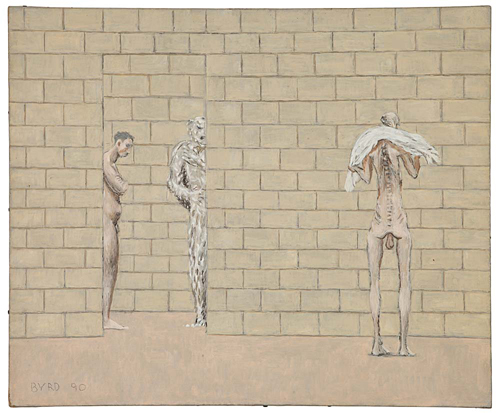
Three Patients in a Shower Room (1990)
There’s not much left without your covering. Clothes make the one and when we un-acommmodate we’re thin as sticks, as brittle, dry. Who’s next?
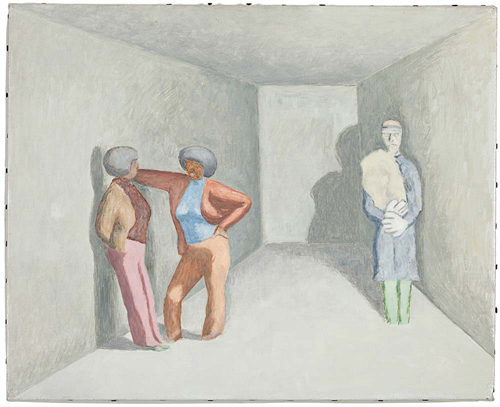
Confab (1986)
Someone or other thinks she might get out; another knows she can’t. She’s carrying the flowers for her grave, as if she could end prettily.
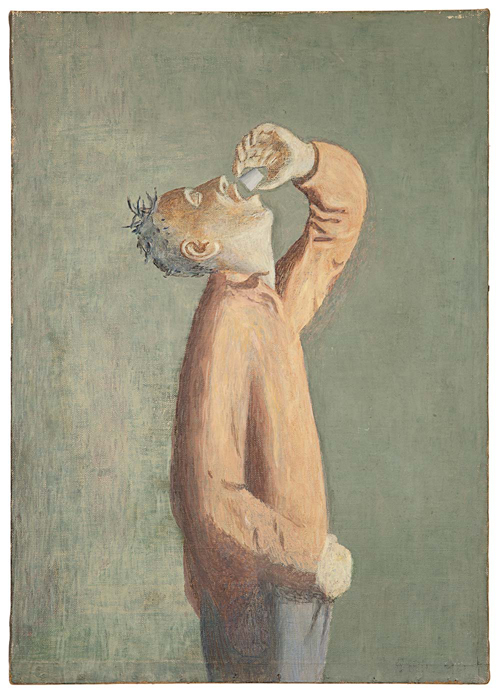
Man Downing His Medicine (1990)
Whatever fills you up might help. You’re hollow as a drain; it goes clear through. Oh pour me in, poor me, I would be fed.

Man Giving a Light (1990)
The light outside is that which casts the shadow. Here, join me. Sit with me.

Man in Bed (1973)
As if a wall of cloth could a nightmare. I’m trying to hold it off and out. I’m trying to hold on.

Patient Hearing Voices (1975)
No evil but inside. If I can keep them in then maybe you won’t hear them too and kick me out. Infected, ashamed. It looks like someone’s coming in for weather.
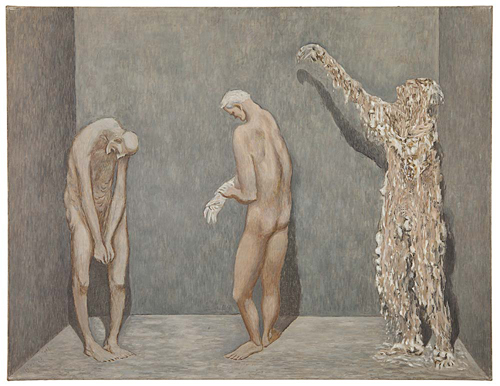
Shower Room Study (1994).
The Evolution of Man.
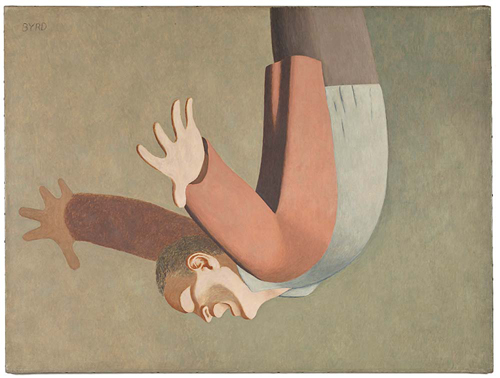
Suicide (1996)
Could there be hope? A fall to joy? Release? I want to eat and bore into the earth. I want to be poured in.
Joe came to see me the week before he died. He was the happiest I’d seen him in his life, like he had had a burden lift from him. He wanted to see where I was living now and how I was doing since I moved. He slept on a mat on the floor by mine. We stayed up late and talked and smoked and told stupid jokes and laughed. Then even after we turned off the lights we kept on talking and and laughing and worrying we were going to wake my housemate. I’d never seen him happier in his life. He said he’d had a good talk with his parents and now he was making a plan. I said I’d take the bus up and help him move but he told me not to bother; he would do it himself.
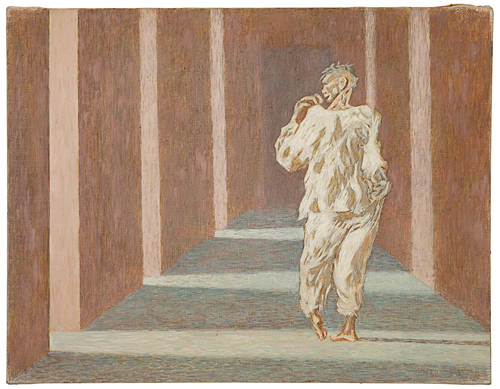
Twisted (1973)
someone is walking
very slowly
somewhere
how does the light
come through
from whence
it comes in through
wherever it can find
an opening
+ + +
Self Portrait (2004)
David Byrd, 1926 - 2013, thank you.
Rest in Love.
— Rebecca Brown
Seattle, August 19, 2013
GREG KUCERA GALLERY, INC.
212 Third Avenue S | Seattle WA 98104
206.624.0770
www.gregkucera.com
Note from Trickhouse Curator, Noah Saterstrom:
At the Art Mkt art fair in San Francisco this Spring, I found myself drawn to Greg Kucera's booth showing David Byrd's paintings. These images seemed to hum quietly, when so many other gallery booths were screeching for attention. Meanwhile, Rebecca Brown was attending Byrd's full exhibition at Greg Kucera Gallery in Seattle. Upon returning home, still thinking about the paintings, I contacted Greg to ask if there was interest in a feature on Byrd for Trickhouse. He told me about Byrd's secluded life, persistent artistic vision, the highly successful opening to his recent first exhibition, and his deteriorating health. I contacted Rebecca to ask if she'd be interested in writing on Byrd for Trickhouse. Greg gave Rebecca a private tour of the sprawling exhibition so she could take notes for the piece published above. A week later, Greg got in touch with us to let us know David Byrd had died. I would like to thank Rebecca and Greg for allowing Trickhouse to publish this as a celebration of both synchronicity and the life of this remarkable painter.
